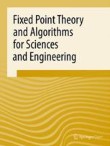In a wide range of mathematical, computational, economical, modeling and engineering problems, the existence of a solution to a theoretical or real world problem is equivalent to the existence of a fixed point for a suitable map or operator. Fixed points are therefore of paramount importance in many areas of mathematics, sciences and engineering.
The theory itself is a beautiful mixture of analysis (pure and applied), topology and geometry. Over the last 60 years or so, the theory of fixed points has been revealed as a very powerful and important tool in the study of nonlinear phenomena. In particular, fixed point techniques have been applied in such diverse fields as biology, chemistry, physics, engineering, game theory and economics.
In numerous cases finding the exact solution is not possible; hence it is necessary to develop appropriate algorithms to approximate the requested result. This is strongly related to control and optimization problems arising in the different sciences and in engineering problems. Many situations in the study of nonlinear equations, calculus of variations, partial differential equations, optimal control and inverse problems can be formulated in terms of fixed point problems or optimization.
The aim of this journal is to report new fixed point results, methods and algorithms as well as their applications in which the indispensability of the fixed point results is highlighted or is the common substrate. It will cover topics such as
· Applications to Differential Equations and Dynamical Systems
· Computational Methods
· Convex and Nonlinear Analysis
· Fractional Calculus and Fractional Differential Equations
· Fuzzy Fixed Point Theory
· Metric Fixed Point Theory
· Nonlinear Analysis and Partial Differential Equations
· Numerical Analysis and Optimization
· Optimization and Control Theory
· Real World Applications
· Set-Valued and Variational Analysis
· Social and Behavioral Sciences
· Topological Methods in Nonlinear Analysis
This journal will accept high quality articles containing original research results and survey articles of exceptional merit. An article to be published in Fixed Point Theory and Algorithms for Sciences and Engineering must either contain some new applications to real world problems or reveal novel aspects of the theory applicable to new situations. Fixed Point Theory and Algorithms for Sciences and Engineering uses continuous article publishing, so your article will be published immediately on the website in a single annual issue.
